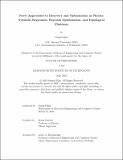Novel Approaches to Discovery and Optimization in Physics: Symbolic Regression, Bayesian Optimization, and Topological Photonics
Author(s)
Kim, Samuel
DownloadThesis PDF (10.25Mb)
Advisor
Soljačić, Marin
Terms of use
Metadata
Show full item recordAbstract
Computational tools including high-fidelity simulations, optimization algorithms, and more recently, machine learning, have become increasingly important in furthering scientific and engineering innovations as available computational power and computing methodologies have both advanced significantly. However, as our understanding of the world and the systems we study correspondingly increase in complexity, there is still a need for designing novel computational methods. In this thesis, I describe three major innovations in which I use optimization and machine learning to automate scientific discovery, optimization, and inverse design.
First, I propose a neural network-based method to perform symbolic regression and automatically learn the underlying equations from high-dimensional and complex datasets. The neural network-based model can integrate with other deep learning architectures, thus taking advantage of the powerful capabilities of deep learning for the task of scientific discovery. Second, I demonstrate the usage of Bayesian neural networks as a surrogate model in Bayesian optimization to enable global optimization of high-dimensional, non-convex problems including topology optimization of photonic crystals and chemical property optimization of molecules. On these complex tasks, my method is able to outperform more commonly used surrogate models and improve optimization in terms of both sampling efficiency and computational cost of training. Finally, I develop a framework for global optimization and automated discovery of 3D topological photonic crystals using a combination of a low-dimensional level-set parameterization and standard gradient-free optimization algorithms. My approach is able to discover novel 3D photonic crystals in several topology settings requiring no prior knowledge of topological candidates, thus indicating a path towards the automated discovery of novel topological photonic crystal designs.
Date issued
2023-06Department
Massachusetts Institute of Technology. Department of Electrical Engineering and Computer SciencePublisher
Massachusetts Institute of Technology